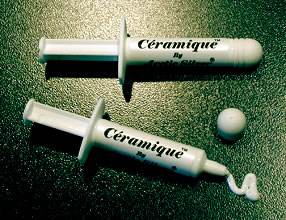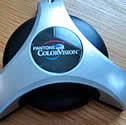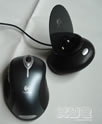Friday, 30 July 2004
Page 3 of 6

[courtesy of ArcticSilver.com]
|
Ceramique |
AS5 |
Thermal
Resistance:
<0.007°C-in2/Watt (0.001 inch
layer) |
Thermal
Resistance:
<0.0045°C-in2/Watt (0.001
inch layer) |
Thermal Conductance:
>200,000W/m2.°C (0.001 inch
layer) |
Thermal
Conductance:
>350,000W/m2 °C (0.001 inch
layer) |
Average Particle
Size:
<0.38 microns
<0.000015 inch
( 67 particles lined up in a row equal 1/1000th of an inch.
) |
Average Particle
Size:
<0.49 microns <0.000020 inch
|
Temperature limits:
Peak: –150°C to >180°C Long-Term: –150°C to
125°C |
Temperature
Limits:
Peak: –50°C to >180°C Long-Term: –50°C to
130°C |
Above are AS's specs on the two compounds. Though these numbers mean very
little to the average user you can tell that the Thermal Resistance and Thermal
Conductance are both a great deal better for AS5 than for Ceramique. The real
question is how these ratings translate into real-life performance.
Before the testing let's go over some preliminary information.
As far as the price in concerned:
|
Package |
Size (grams) |
Price (USD) |
$/gram |
|
AS5 |
3.5 |
7.50 |
2.14 |
|
AS5 |
12.0 |
16.00 |
1.33 |
|
Ceramique |
2.7 |
5.00 |
1.85 |
|
Ceramique |
22 |
10.00 |
0.45 |
Though the Ceramique is a good deal cheaper than the AS5 we are only talking
in terms of a few dollars so what really matters is performance. Cost
effectiveness is not so much on an issue due to the minimal price of the
product.
|

 Reviews
Reviews  Misc.
Misc.  Arctic Silver Thermal Compounds
Arctic Silver Thermal Compounds 






